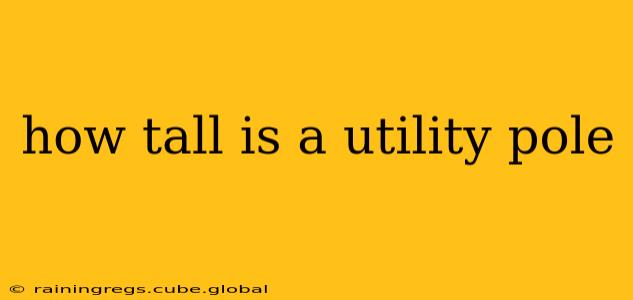How Tall is a Utility Pole? Understanding the Variations
The height of a utility pole isn't a one-size-fits-all answer. Several factors influence how tall these essential structures are, leading to a range of heights rather than a single definitive measurement. Let's delve into the specifics to get a clearer picture.
What Determines the Height of a Utility Pole?
The height of a utility pole is primarily determined by several key factors:
-
Voltage: Higher voltage transmission lines require taller poles to provide sufficient clearance for safety and to prevent electrical arcing. Lower voltage lines, such as those supplying residential areas, can utilize shorter poles.
-
Terrain: Poles in hilly or mountainous areas often need to be taller to maintain consistent line clearance and avoid sagging. Flatter terrain allows for shorter poles.
-
Local Regulations & Codes: Building codes and local regulations play a significant role in dictating minimum height requirements for utility poles to ensure public safety. These codes often consider factors like vehicle and pedestrian traffic patterns.
-
Line Configuration: The design of the power lines themselves, including the number of conductors and the type of insulators used, also impacts the necessary pole height.
-
Environmental Considerations: Factors like tree growth and potential for high winds may necessitate taller poles to prevent interference and ensure stability.
Typical Heights of Utility Poles: A Range of Possibilities
While there's no single definitive answer, here's a general range:
-
Residential areas (low voltage): These poles typically range from 30 to 40 feet (9 to 12 meters) tall.
-
Commercial and industrial areas (medium voltage): Poles in these areas tend to be taller, often between 40 and 60 feet (12 to 18 meters).
-
Transmission lines (high voltage): These can be significantly taller, ranging from 80 to over 100 feet (24 to over 30 meters) or even taller, depending on the voltage and terrain.
How Tall are Telephone Poles?
Telephone poles are often smaller than power poles, especially in residential areas, frequently measuring between 30 and 40 feet (9 to 12 meters) tall. However, they can also vary in height based on factors similar to those affecting power poles, such as terrain and line configuration.
What are the Different Types of Utility Poles?
Utility poles are constructed from a variety of materials, including:
-
Wood: Still a common material, especially for lower-voltage lines. Creosote treatment helps extend their lifespan and protect them from decay.
-
Concrete: Concrete poles are becoming increasingly popular due to their durability and long lifespan.
-
Steel: Steel poles are frequently used for high-voltage transmission lines, offering strength and resistance to high winds and extreme conditions.
Are there any safety concerns related to utility pole height?
Yes, maintaining proper height is crucial for safety. Insufficient height can lead to accidental contact with power lines, causing serious injury or even death. Therefore, utility companies regularly inspect and maintain their poles to ensure they meet safety standards and regulations. Never attempt to climb or approach a utility pole without proper training and safety equipment.
This comprehensive overview offers a clearer understanding of the factors that influence utility pole height. Remember, the next time you see a utility pole, consider the factors that may have determined its particular height.
